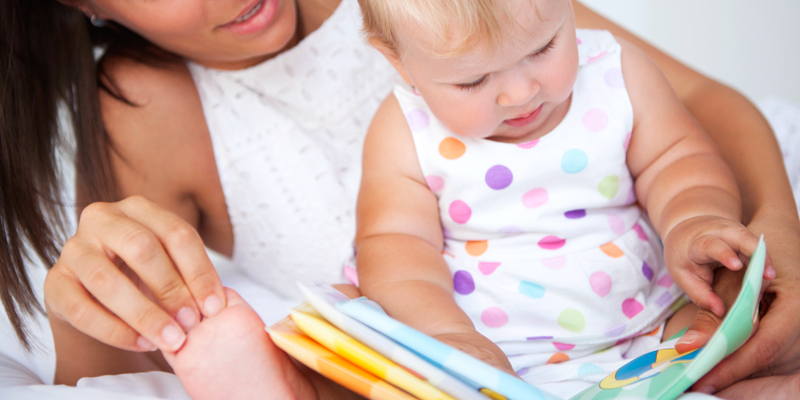
Looking at Illustrations
At this age, your baby will begin to develop an Awareness of Print and Illustrations by responding to some of the words that are part of her picture books. A child’s awareness of print refers to her knowledge that words have meaning and that print is all around, as well as her understanding of how to handle books and other reading materials.1 She will begin to look more carefully at the pictures and may even develop a preference for some of the objects she sees.2 She’ll get excited by her favorite objects, squealing and grabbing at the book.3 Your baby will soon be able to respond to some of the words that are part of her picture books by pointing out objects that you name. For example, she may point to a mouse when you ask “Where’s the mouse on this page?” She may even start holding the book herself with support.2
Take note that for now, your baby will respond the most to brightly colored picture books with simple shapes and objects, rather than complicated images with soft, pastel colors. Picture books with textured fabrics or other materials are also great at this age. This additional feature helps babies deepen their understanding of what they are seeing and hearing. So the next time you read about animals or common objects, pick up a textured book to highlight how soft a cat’s fur is or how leathery an elephant’s skin feels.4
Be sure to keep some board books handy. Her interest in books will most likely lead to the same place that any other interesting object ends up: her mouth! Board books are durable enough to allow her to explore her favorite stories without hurting them.5 Take the opportunity, though, to show her how to care for a book and demonstrate how to turn the pages. Before long, as her fine motor skills develop, she will figure out how to do this on her own.
(SPECIAL OFFER: Sign up for Playful Bee’s Bee Well developmental learning program to give your baby the best start in life. The first 10,000 children enroll for FREE! Sign up today.)
Play Tips:
Do you want to know how you can support your baby’s development of these Awareness of Print and Illustrations skills at this age? It’s easy! Read on for some simple tips to incorporate into your daily play time together.
- Read simple picture books over and over again.2 Your baby will build her vocabulary and learn that illustrations carry meaning from repeated exposure to the same books and pictures. Point to the pictures and name the objects as you read together.
- Look at first word books together. First word books are a great way to expand your baby’s vocabulary. These books are quite simple, but there are many out there on a variety of subjects, and you’re sure to find one that interests your child. In addition to the words on the page, you can talk about details in the pictures. For example, if you’re looking at a book of farm animals, you can talk about the different parts of the animal, what color it is, what it eats, and more.
(SPECIAL OFFER: Sign up for Playful Bee’s Bee Well developmental learning program to give your baby the best start in life. The first 10,000 children enroll for FREE! Sign up today.)
Developmental Milestones:
Has your baby achieved the following Awareness of Print and Illustrations developmental milestones yet? If yes, check off all the skill(s) he has already mastered to date using Playful Bee’s developmental milestones tracker. It’s absolutely FREE and easy to use, just click HERE!
- Starts looking more carefully at picture in books.*
Sources:
1Idaho Commission of Libraries, 2009. Print Awareness. Retrieved January 6, 2014, from http://libraries.idaho.gov/files/LitCentersPrintAware2009Ssha_0.pdf.
2Maryland State Department of Education (2010). Healthy Beginnings: Supporting Development and Learning from Birth through Three Years of Age.
3Quick, Carol A. (2013). Reading Books to Babies. KidsHealth. Retrieved September 25, 2014, from http://kidshealth.org/parent/positive/all_reading/reading_babies.html#.
4Center for Early Learning Literacy (2010). The Right Touch. Center for Early Learning and Literacy. Retrieved December 15, 2013, from http://www.earlyliteracylearning.org/pgparents.php.
5Griswold, Jerry. 5 Board Books for Baby. Parents’ Choice: Children’s Media & Toy Reviews.Retrieved September 25, 2014, from http://www.parents-choice.org/article.cfm?art_id=389&.
Acredolo L, and Goodwyn S. (1988). Symbolic Gesturing in Normal Infants. Child Development, 59(2): 450-466.
Playful Bee
Latest posts by Playful Bee (see all)
- Have a Super Fortune Cookie Friday! - February 9, 2018
- All Kinds of Shapes: Your Child Is Learning Simple Shapes, and Drawing Them Too! - November 13, 2017
- Fishing for Sneakers: Create your own Hand-Eye Coordination Fun - November 11, 2017

+ There are no comments
Add yours